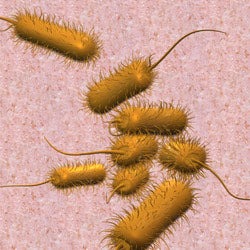To put it briefly, these organisms are good indicators of the potential contamination of a water source. Coliform bacteria have been used to evaluate the general quality of water. Testing for coliform bacteria is faster and cheaper than testing for specific organisms and pathogens. U.S. Public Health Service established a standard in 1914. Coliforms include all aerobic and facultatively anaerobic, gram-negative, non-spore-forming bacilli that, when incubated at 35 C, can ferment lactose and produce gas (CO2) within 48 hrs. Fecal coliforms are the coliform bacteria that originate specifically from the intestinal tract of warm-blooded animals (e.g., humans, beavers, raccoons, etc.).

They are cultured by increasing the incubation temperature to 44.5 C and using somewhat different growth media. Two other groups of bacteria that are present in feces are: fecal streptococci and Clostridium. Clostridia spores can survive a long time during adverse conditions. This genus occurs naturally in soils and polluted waters; it is not used for monitoring purposes. Fecal streptococci and enterococci are terms that have been used interchangeably; however, there are some differences between the two groups.
Coliform organisms are used as indicators of water pollution. The coliform organism is a very common rod-shaped bacterium, not thought of as disease causing to humans. Because pathogenic bacteria in wastes and polluted waters are usually much lower in numbers and much harder to isolate and identify than coliforms, which are usually in high numbers in polluted water, total coliforms are used as a general indicator of potential contamination with pathogenic organisms. However, many coliform bacteria live in the soil, and these organisms may be the source of those that appear in the water, especially surface water. Fecal coliforms, on the other hand, are more specific because they refer to the coliforms that live in the intestinal tract of humans and many other animals.
Fecal coliforms are a good indicator of contamination from human or other animal waste products and they indicate a greater risk of exposure to pathogenic organisms than total coliforms. Each person discharges from 100 to 400 billion fecal coliform organisms per day. Some animals discharge much more. A water system tests for these bacteria routinely. If EPA’s safety standards for these contaminants are exceeded, your water system will take action to correct the deficiency, and in the interim, issue an alert with guidance on how to protect you and your family. If you are on a private water system, the local health department will assist you, for a fee, in regularly testing your water supply for these organisms and pathogens.
Pathogens are relatively scarce in water, making them difficult and time-consuming to monitor directly. Instead, fecal coliform levels are monitored, because of the correlation between fecal coliform counts and the probability of contracting a disease from the water. Cities and suburbs sometimes contribute human wastes to local rivers through their sewer systems. A sewer system is a network of underground pipes that carry wastewater. In a separate sewer system, sanitary wastes (from toilets, washers, and sinks) flow through sanitary sewers and are treated at the wastewater treatment plant. Storm sewers carry rain and snowmelt from streets, and discharge untreated water directly into rivers. Heavy rains and melting snow wash bird and pet wastes from sidewalks and streets and may "flush out" fecal coliform from illegal sanitary sewer connections into the storm sewers.
In a combined sewer system, sanitary wastes and storm runoff are treated at a wastewater treatment plant. After a heavy rain, untreated or inadequately treated waste may be diverted into the river to avoid flooding the wastewater treatment plant. To avoid this problem, some cities have built retention basins to hold excess wastewater and prevent untreated wastes from being discharged into rivers. Without retention basins, heavy rain conditions can result in high fecal coliform counts downstream from sewage discharge points. That is why it is important to note weather conditions on the days before a fecal coliform measurement.



